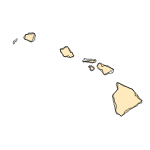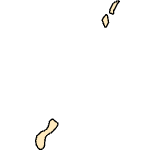Astatotilapia calliptera
(eastern happy)
Fishes
Exotic |
|
Common name: eastern happy
Synonyms and Other Names: Haplochromis callipterus (Günther 1894)
Taxonomy: available through
www.itis.gov
Size: to 15 cm SL (Eccles 1992)
Native Range: Africa: Lakes Malawi, Chiuta, and Chilwa, and Zambezi River.



|

Alaska |

Hawaii |

Puerto Rico &
Virgin Islands |

Guam Saipan |
Hydrologic Unit Codes (HUCs) Explained
Interactive maps: Point Distribution Maps
Nonindigenous Occurrences:
Table 1. States with nonindigenous occurrences, the earliest and latest observations in each state, and the tally and names of HUCs with observations†. Names and dates are hyperlinked to their relevant specimen records. The list of references for all nonindigenous occurrences of Astatotilapia calliptera are found here.
Table last updated 11/24/2024
† Populations may not be currently present.
Ecology: Inhabits shallow, vegetated nearshore areas in lakes, and adjacent streams or rivers (Konings 1990; Eccles 1992). Consumes a variety of prey, including benthic invertebrates, algae, and small fishes (Konings 1990).
Means of Introduction: Likely aquarium release.
Status: Unknown. Persistence over ~10 years and variable catch rates among years indicates that this species has reproduced (Shafland et al. 2008). However, a lack of reported specimens since 2007 suggests that this species may be extirpated from Florida.
Impact of Introduction: Unknown. Could potentially compete with co-occurring native fishes for food; however, its relatively small size makes this species a potential prey item for larger piscivorous fishes.
References: (click for full references)
Konings, A. 1990. Ad Koning's book of cichlids and all the other fishes of Lake Malawi. Tropical Fish Hobbyist Publications, Neptune City, NJ.
Eccles, D.H. 1992. FAO species identification sheets for fishery purposes: field guide to the freshwater fishes of Tanzania. Food and Agriculture Organization of the United Nations, Rome, Italy. http://www.fao.org/docrep/010/t0605e/t0605e00.htm
Shafland, P.L., K.B. Gestring, and M.S. Stanford. 2008. Florida's exotic freshwater fishes - 2007. Florida Scientist 71(3):220-245.
Skelton, P.H. 2001. A complete guide to the freshwater fishes of southern Africa. Struick Publishers, South Africa.
FishBase Summary
Author:
Matt Neilson, and Pam Fuller
Revision Date: 5/7/2019
Peer Review Date: 6/15/2015
Citation Information:
Matt Neilson, and Pam Fuller, 2024, Astatotilapia calliptera (Günther, 1894): U.S. Geological Survey, Nonindigenous Aquatic Species Database, Gainesville, FL, https://nas.er.usgs.gov/Queries/FactSheet.aspx?SpeciesID=2597, Revision Date: 5/7/2019, Peer Review Date: 6/15/2015, Access Date: 11/24/2024
This information is preliminary or provisional and is subject to revision. It is being provided to meet the need for timely best science. The information has not received final approval by the U.S. Geological Survey (USGS) and is provided on the condition that neither the USGS nor the U.S. Government shall be held liable for any damages resulting from the authorized or unauthorized use of the information.